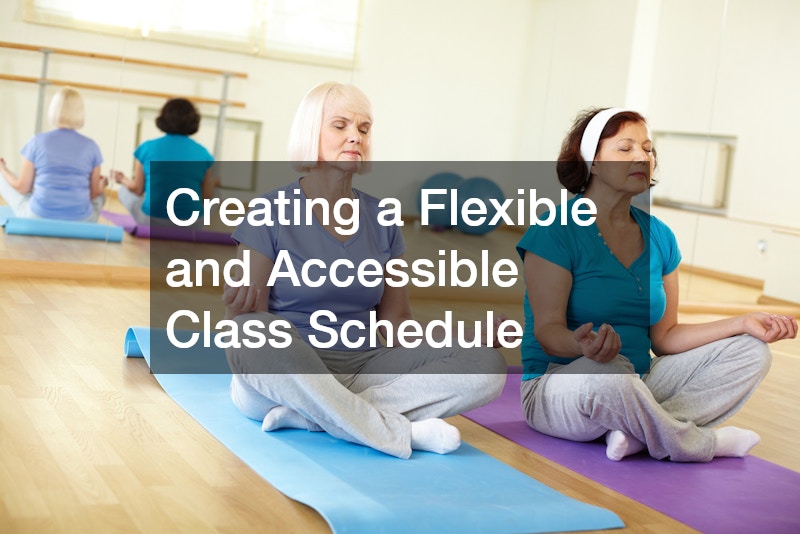Introduction
Starting a yoga studio that offers yoga drop in classes can be a fulfilling and profitable venture, but it requires careful planning and attention to detail. In this business model, flexibility is key, as customers may not want to commit to long-term memberships and prefer the freedom to attend classes at their convenience. Creating an inviting and functional space, hiring skilled instructors, and building a strong connection with the community are all crucial components of success. By focusing on the core elements of your business, you can design a studio that not only meets the needs of drop-in clients but also fosters a welcoming environment that encourages repeat visits. Whether you’re just starting or looking to expand an existing business, each decision plays a vital role in how your yoga studio will operate and grow.
Choosing the Right Location for Your Yoga Studio
Finding the perfect location is essential when opening a studio that offers yoga drop in classes. The location will determine your studio’s accessibility and visibility, which are key factors in attracting new clients. Ideally, your studio should be situated in a high-traffic area or a neighborhood that aligns with the demographics of your target market. Easy access to public transportation, nearby parking, and a convenient proximity to other businesses can also help increase foot traffic to your studio. A great location not only enhances your chances of gaining new customers but also makes it easier for existing clients to attend classes, contributing to a more successful business overall.
In addition to considering the practical aspects of location, it’s important to consult with lawyers to ensure your leasing or purchasing agreements are sound. Legal professionals can help you navigate the complexities of zoning laws, rental agreements, and property regulations that are often involved in establishing a yoga studio. By working with lawyers, you can secure a space that meets legal requirements and positions your business for success in offering yoga drop in classes. Their guidance ensures that you’re not only choosing the right location but also protecting your investment.
Designing an Inviting and Functional Studio Space
The layout and design of your yoga studio play a significant role in how comfortable and inviting it feels to your customers. A well-designed space should encourage relaxation and focus, which are essential for yoga practice. Natural light, calming colors, and open areas free from clutter can enhance the overall ambiance of the studio. When offering yoga drop in classes, it’s especially important that the space is flexible and can accommodate varying class sizes without feeling cramped. Thoughtful design choices will contribute to creating an environment where students feel motivated and at ease.
One way to add a unique touch to your studio’s design is by incorporating commissioned metal art designs. These custom pieces can serve as focal points in your space, adding personality and a sense of creativity. Whether it’s a sculpture or wall art, commissioned metal art designs can complement your studio’s aesthetic and make it feel more welcoming. By carefully considering how your space is designed and incorporating art, you are creating a functional yet inspiring environment that aligns with the needs of yoga drop in classes, ensuring clients will feel at home whenever they visit.
Selecting the Best Equipment for Yoga Drop In Classes
Equipping your yoga studio with the right tools is critical for providing a top-notch experience to your students. High-quality mats, yoga blocks, straps, and blankets are the basic essentials that will help students perform poses safely and comfortably. Since yoga drop-in classes can attract students of all skill levels, having a variety of props available ensures that everyone can participate, regardless of their flexibility or strength. Investing in durable and easily sanitized equipment is important, as you’ll need to maintain cleanliness and quality in a busy, drop-in environment. The right equipment not only improves the functionality of your classes but also demonstrates your commitment to providing a professional and supportive space for your clients.
To ensure your studio has the best equipment and flooring for yoga drop in classes, consider utilizing laminate flooring installation. This type of flooring is affordable, durable, and easy to clean, making it ideal for a yoga studio that hosts multiple classes per day. Laminate floors provide a smooth surface for yoga mats and can withstand heavy foot traffic, making them a practical choice for busy studios. By focusing on quality equipment and proper flooring, you’re setting your studio up for long-term success and enhancing the experience for every drop-in client who walks through the door.
Hiring Experienced and Certified Yoga Instructors
The instructors you hire play a pivotal role in the success of your yoga studio, particularly when offering yoga drop in classes. Since drop-in students may attend sporadically, they rely on the instructor to guide them through the class in a way that accommodates different skill levels and ensures a fulfilling experience. A knowledgeable, certified instructor who can create a welcoming environment is essential for retaining these clients. The quality of the instructors will often determine whether a first-time visitor becomes a regular client, so it’s important to hire individuals who are not only skilled but also personable and adaptable.
Partnering with professionals in fields like local chiropractic treatment can also enhance the expertise offered by your instructors. Yoga and chiropractic care share a focus on flexibility, alignment, and overall well-being, and instructors who are knowledgeable about these areas can provide more informed guidance to students. By integrating insights from chiropractic practices into your yoga drop in classes, your instructors can help students avoid injury and improve their practice, making your studio an even more attractive option for those seeking wellness and fitness benefits.
Creating a Flexible and Accessible Class Schedule
One of the main appeals of yoga drop in classes is the flexibility they offer to students. With busy lives and unpredictable schedules, many people are unable to commit to fixed class times or long-term memberships. Offering a range of class times throughout the day and week can help accommodate different lifestyles and attract a wider variety of clients. Early morning, lunchtime, and evening classes allow people to fit yoga into their schedules, increasing your studio’s accessibility. A diverse and adaptable schedule makes it easier for clients to engage in yoga on their own terms, which is a major advantage when promoting drop-in classes.
Maintaining a comfortable studio environment is also key to attracting clients with varying schedules. Regular HVAC repairs can ensure that your space is consistently at a comfortable temperature, regardless of the season. No one wants to attend yoga drop-in classes in a too-hot or too-cold studio, so keeping your HVAC system in top condition is essential. By creating a flexible class schedule and ensuring your studio remains comfortable year-round, you’re offering convenience and comfort that aligns with the needs of modern clients, making your studio a go-to destination for drop-in yoga sessions.
Marketing Your Studio to Attract Drop-In Clients
Effective marketing is crucial for attracting new customers to your studio, especially those interested in yoga drop-in classes. Since many drop-in clients may be new to yoga or looking for flexibility, your marketing efforts should emphasize convenience, accessibility, and a welcoming environment. Social media, local advertising, and community outreach can all play a role in promoting your studio. By showcasing the benefits of yoga drop-in classes—such as no commitment, affordable rates, and diverse class offerings—you can reach a wider audience that may not be ready to sign up for long-term memberships. Highlighting the value of drop-in flexibility can help you appeal to individuals who are hesitant to commit but still want to experience the benefits of yoga.
In addition to digital marketing, partnering with commercial cleaners can help ensure that your studio maintains the pristine, inviting appearance needed to attract new clients. A well-maintained and spotless facility speaks volumes about your professionalism and dedication to creating a positive experience. When potential clients see that your studio is clean and well-cared-for, they’ll be more likely to drop in and see what your classes are all about. By focusing on both marketing and cleanliness, you can build a strong reputation and attract consistent traffic to your yoga drop-in classes.
Setting Competitive Pricing for Drop-In Yoga Classes
Pricing is a critical factor when setting up a studio that offers yoga drop-in classes. Since you’re catering to clients who may not want to commit to long-term packages, it’s essential to offer pricing that reflects the flexibility of drop-in sessions. Competitive pricing can attract a steady flow of clients, especially if you balance affordability with value. Offering discounts for bulk drop-in passes or special rates for first-time students can further incentivize customers to try your studio. Keeping your pricing structure transparent and fair will help build trust with your clientele and make your studio a more appealing option for people looking for flexible yoga solutions.
In the same way that competitive pricing attracts clients, it’s also important to maintain the quality of your studio by addressing potential damage promptly. Collaborating with local water damage companies can help you quickly fix any water-related issues that may arise. Water damage, if left unchecked, can cause costly repairs and disrupt your business operations, potentially driving away clients. By keeping your studio in top shape and offering affordable drop-in rates, you can ensure that your yoga studio remains a popular choice for customers seeking flexibility in their practice.
Establishing a Welcoming and Inclusive Studio Atmosphere
Creating an inclusive and welcoming environment is key to the success of any yoga studio, especially one offering yoga drop-in classes. Your studio should be a place where people of all backgrounds, skill levels, and body types feel comfortable and supported. This atmosphere can be cultivated through the attitude of your instructors, the tone of your marketing, and the overall environment of the studio. Offering beginner-friendly classes, emphasizing a non-judgmental space, and promoting inclusivity in your messaging are all ways to foster a warm, community-oriented atmosphere. When students feel welcomed and included, they’re more likely to return and recommend your studio to others.
Part of establishing this inviting atmosphere is ensuring that your studio is physically accessible and welcoming from the moment clients walk in. Investing in commercial door installation can make your entryways not only more accessible but also more secure and professional. Wide, automatic, or easy-to-open doors signal that your studio is thoughtful and accommodating to clients of all abilities. By focusing on inclusivity and functionality, you’ll create a space where people are excited to drop in for yoga classes, knowing that your studio values their comfort and convenience.
Ensuring Your Studio Meets Legal and Safety Requirements
When starting a yoga studio that offers yoga drop-in classes, adhering to legal and safety requirements is paramount. This includes complying with zoning laws, securing proper permits, and ensuring that your building meets safety codes. A yoga studio should be a safe space for clients to practice, so making sure the facility is up to code can prevent accidents and legal issues down the line. It’s also essential to have clear policies on liability waivers, especially for drop-in clients who may not be familiar with your studio’s rules. By addressing these requirements early on, you can avoid potential legal complications and ensure that your studio operates smoothly.
One key aspect of meeting safety requirements is working with a concrete contractor to ensure that the structure of your studio is sound. If you’re renovating or building from scratch, ensuring that floors, walkways, and other structural elements are safe and up to code is essential. A professional concrete contractor can address any foundational or flooring concerns, which is particularly important for high-traffic areas in a yoga studio offering drop-in classes. This attention to detail will help protect your clients and your business, ensuring that your studio is a safe and reliable place for yoga drop-in classes.
Building a Strong Community Through Drop-In Classes
A strong sense of community can be one of the most powerful aspects of running a successful yoga studio. Even though drop-in clients may not be regular attendees, it’s important to make them feel like they’re part of a larger community. Hosting workshops, community events, and social gatherings can foster relationships among students, even those who only attend drop-in classes. Encouraging interaction and inclusivity helps build a welcoming environment that keeps clients coming back. The stronger your community, the more likely it is that your studio will attract loyal customers and grow through word-of-mouth recommendations.
Maintaining the integrity and aesthetics of your building can further contribute to a strong sense of community. Local roofing companies can help ensure that your studio remains in top condition, protecting both the physical structure and the comfort of your clients. A sturdy, well-maintained roof can prevent leaks and damage that might disrupt classes or make your space less inviting. By combining high-quality facility maintenance with efforts to build community, you create an environment where students feel valued and are eager to participate in your yoga drop-in classes.
Conclusion
Starting a studio that offers yoga drop-in classes requires thoughtful planning and a focus on creating a welcoming, functional, and safe environment. From selecting the right location and designing a beautiful studio space to ensuring legal compliance and fostering a strong community, each aspect plays a crucial role in the studio’s success. By prioritizing flexibility in your class schedules, hiring experienced instructors, and maintaining a clean and safe facility, you set the foundation for a thriving business. Drop-in clients appreciate convenience, comfort, and value, and by meeting these needs, your studio can become a trusted and popular destination. Whether through partnerships with local contractors, ensuring high-quality equipment, or cultivating an inclusive atmosphere, each decision you make will contribute to the long-term success of your yoga studio.









